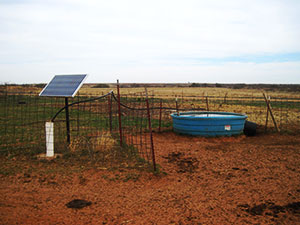Conservation Districts Aiding Drought Weary Farmes & Ranchers
Hurting for water, farmers and ranchers of five Oklahoma counties have tapped emergency funds meant to bring water to crops and grazing land and conserve what water is already there.

Conservation districts in Greer, Harmon, Jackson, Texas, and Tillman counties have partnered with USDA Natural Resources Conservation Service (NRCS) and the Oklahoma Conservation Commission to support local producers in combatting the effects of drought on agricultural operations. Three rounds of Emergency Drought Cost-Share Program allocations were made totaling $375,000.
On a patch of land managed by Greer County farmer and rancher Scotty Webb, water is again flowing where cattle haven’t grazed since 2012. “The place we ended up doing this [installing a solar water pump], is 360 acres with no water anywhere. Two ponds went dry,” Webb said.
That’s a familiar story among agricultural producers in the Oklahoma counties considered by the U.S. Drought Monitor to be in extreme to exceptional drought—the most severe drought categories. Due to lack of water, many have reduced or completely eliminated cattle herds and crops.
If not for the solar water pump Webb installed using emergency drought funds, that pasture would be unable to support livestock. This means Webb’s cattle would stay on their current pasture, risking overgrazing and further harm to the drought damaged land. Other practices made possible by the cost-share funds include pasture establishment, water well drilling, pipelines, and taps to rural water utilities.
“I’ve been fortunate to hold on to what I have,” Webb said. “There are lots of people who have sold out.”
Staying strong
In order to hold on, Webb reduced the size of his herd, but he also adopted conservation practices encouraged by his conservation district such as rotational grazing and no-till farming. Rotational grazing is the practice of moving livestock from one partitioned pasture area to another in order to maximize a pasture’s ability to adequately feed livestock while maintaining healthy plant growth for future grazing. By contrast, continuous grazing allows livestock to freely graze anywhere and can lead to under and overgrazed land. No-till farming is farming without tilling or turning up the soil, and leaving it covered with residue and plant cover. Contrary to conventional wisdom, tilled soil is less able to take in water and nutrients and, due to loss of root systems and living organisms such as fungi and worms in the soil, tilled soil is less able to make what nutrients it does contain available to crops.
Despite 2012 drought conditions worse than those seen during the 1930s Dust Bowl, Oklahoma farmers and ranchers have been able to prevent the devastating dust storms and widespread erosion seen during that time by working with local, state, and federal conservation partners to implement voluntary conservation practices that protect soil, air and water quality and benefit local economies.
Executive order
Governor Mary Fallin activated the Emergency Drought Commission in November 2013. The Drought Commission is comprised of Oklahoma Secretary of Agriculture Jim Reese, Oklahoma Conservation Commission executive director, Mike Thralls, and Oklahoma Water Resources Board executive director J.D. Strong.
The Drought Commission designated the Conservation Commission as the lead state agency to disburse drought relief funds to individual farmers and ranchers via the Emergency Drought Cost-Share Program. With the assistance of USDA NRCS, conservation districts in the five counties under drought emergency used the program to distribute funds based on a ranked application system.
In cost-share programs such as the Emergency Drought Cost-Share Program and the Conservation Commission’s Locally-Led Cost-Share Program, conservation districts may pay up to 75 percent of the cost of implementing a conservation practice. The producer pays the remaining portion.
Download this press release as a PDF.
